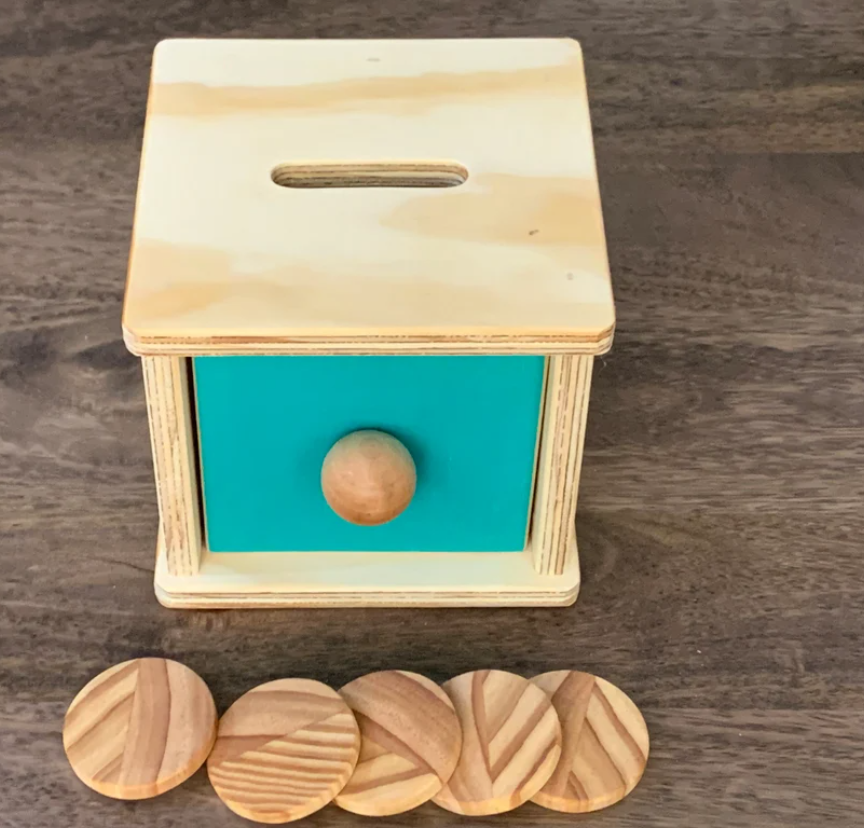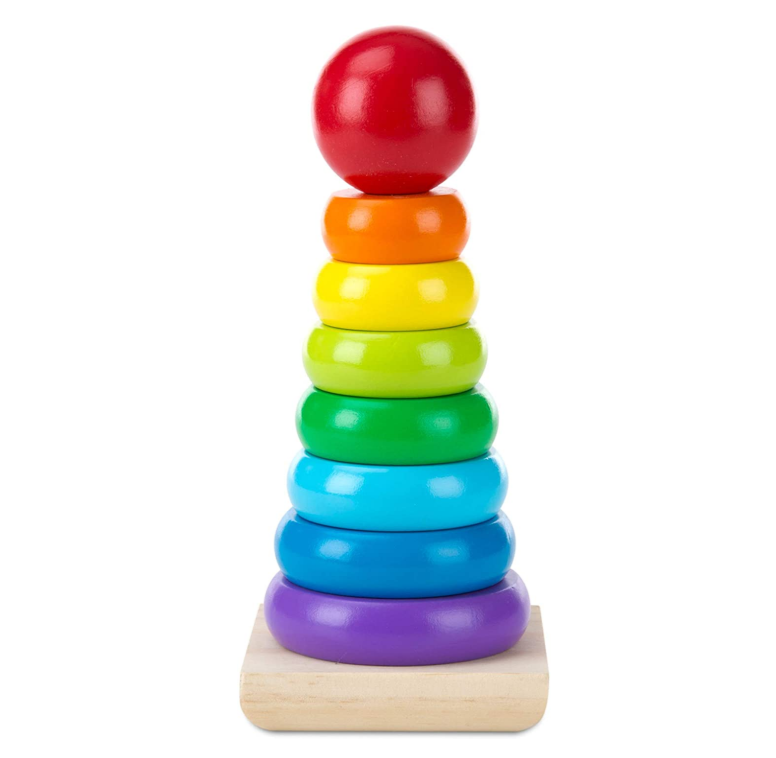Six to Twelve Months
By six months, many babies can start to move around their space by crawling, scooting, pulling up, and creeping. Materials for this age group are focused on encouraging movement, and creating a space where a child can explore without adult interference. This is also the age to introduce solid foods and learning the basics of how to eat independently.
As with the three to six age, it’s still important to avoid any sort of containers that restrict movement like bouncy seats, jumpers, activity chairs, and walkers when possible. These items directly oppose a child's natural inclination to strengthen her muscles and practice movement under her own power. Car seats, strollers, and high chairs can be useful and necessary devices, but time spent in them should be limited as much as possible.
This page contains affiliate links, which help make it possible to bring you this Montessori gift guide. If you purchase an item through one of the links below, we might earn a small commission for referring you, but it won't cost you any extra.
Image from Kiddie Design Etsy Shop
Helper Tower and Table and Chair
The classic learning tower is such a wonderful tool to have in your kitchen, but it does take up a lot of space. However, this helper tower from Kiddie Design folds down into a child-sized table and chair too! Excellent for those of us with small kitchens, or savvy space savers. Use this when your child is standing comfortably. This shop also has a wonderful indoor wooden slide and an infant cube chair set.
Pull up Bar
A wall-mounted pull-up bar is a fantastic material for a newly mobile child. It helps a child enter and maintain a standing position without restricting movement like a walker or bouncy seat would. For maximum fun, install the pull-up bar in front of a child-height unbreakable mirror.
Wall Mirror
A wall mirror is a recommended Montessori material for a child's space from infancy onward. It's typically hung horizontally at the child's level on the wall next to the play mat. An unbreakable acrylic mirror sheet is the best choice for this, since it's impossible to shatter or chip. You can rehang a mirror behind a pull-up bar for this age group.
Lovevery Play Kits
These play kits from LOVEVERY offer an all-in-one solution for parents and gift ideas! For ages 6-12 months, there are three kits available. In each kit you’ll find a small collection of developmentally challenging and engaging toys, a how-to booklet, and books to read together. These kids are designed by Montessori and Early Childhood experts, and promote not just fun, but learning as well. See the kits by clicking the buttons below.
Wooden Coin Box
This box is slightly harder than the open ball drop box from the Lovevery 7-8 month play kit, but is an excellent challenge for an infant around this age. The drawer is easy to open, and makes it simple to play again and again. Try a collection of small, thin scarves tied together through the slot for extra fun!
Treasure Sensory Basket
The treasure basket is a wonderful open-ended material for infants age 6-12 months. Any infant-safe items can be placed in a basket for exploration, and rotated for interest! This set is pre-made for you with lovely textures, colors, and even a small mirror.
Wobble Toy
This toy is a favorite for a reason. Its just hard enough to grasp and does a funny wobble when babies do knock or catch it. This one from Manhattan Toys is fabric and silicone, and also bounces, but an all-wood toy would be fun as well.
Two-Handed Puzzles
The egg and cup is a classic Montessori material for this age group. It's a very simple puzzle that practices hand-eye coordination and concentration. An adult might not find this puzzle very interesting, but to a child at the right developmental stage (around nine months), it's a fascinating and challenging puzzle.
Palmar and Pincer Grasp Blocks
Another simple but fascinating puzzle for children around eight or nine months are palmar and pincer blocks. These puzzles practice two distinct fine motor skills—the palmar (whole hand) grip, and the pincer (two finger) grip. And the concentration required to complete the puzzle is fantastic practice for a developing child.
Stacking Cups
These cups come in a set of 8, but that is too many for a 6-12 month old. Choose 2-3 cups of various sizes, and offer these as a nesting or stacking puzzle. You can also hide a small object under a cup and ask your baby which cup it is under. As your child begins to stack or nest the cups, add the rest of the set back in.
Nesting Bowls
These heirloom quality wooden bowls from Grimm’s offer a similar experience as stacking cups, but with exquisite beauty and durability. Choose 2-3 bowls of various sizes to begin, and offer these as a nesting or stacking puzzle. You can also hide a small object under a bowl and ask your baby which bowl it is under. As your child begins to stack or nest the bowls, add the rest of the set back in.
Wooden Stacking Rings
This classic toy stands the test of time for a reason. Like the pink tower in a Montessori classroom, this toy helps develop a sense of size and the skill of organizing largest to smallest. The complete set of rings is too many for a 6-12 month old. Choose 2-3 rings of various sizes to start. You can demonstrate how to thread the rings onto the base, order doesn’t matter. As your child begins to order the rings by size, add the rest of the set back in.
Nesting Dolls
Another classic toy that can be played with many ways! This set is made from food-grade silicone, which is perfect for younger infants to safely explore. Set this up as a matching game with top and bottom pieces, or offer two dolls of varied sizes to nest together. As your child gets familiar with these, add all four together.
Walker Wagon
The only Montessori recommended walking aid is a walker wagon. This is a gift for a child who is pulling up to stand and can balance on her own two feet for a few seconds (usually around 11 months, but this can vary). A push wagon offers a child a stable surface to assist in balance without negatively affecting her gait. And since the wagon doesn't restrict her movements, she can choose to start and stop using it on her own terms. The walker wagon stays interesting even after a child learns to walk, since she can use it to carry toys and other objects. Look for one that is simply made and colored (we prefer wood over plastic), and one that won’t tip when you pull up on the bar as a baby would.
Soft Ball
A soft ball is a fantastic toy for newly mobile babies. It will roll away, but slowly enough to encourage a child to crawl after it.
Soft Ball
We also like this ball. It has many places to grab, and doesn’t roll very fast. A child can continue to use this ball as he gets older, to throw and kick.
First Spoon
This is our favorite first spoon for babies. It’s soft with curved edges which is gentle on tender gums, and has an easy-to-grasp thick stem. You can use this as a feeding spoon from the very beginning as well as an independent utensil as your baby gains more control over her hands.
First Cup
This is a very small 1 oz cup, which is perfect for small hands to grasp and lift. These are sold as a set of 4 shot glasses, but they are just the right size for learning to use a real cup. Real cups offer practical life and fine motor skill building, as well as developing strong muscles around the mouth for speaking. We also like a thick-walled glass shot glass for a first glass.
Travel Highchair
It’s amazing how many places don’t have highchairs available, and for many six to 12 month olds, the chairs available are just too big and low. We suggest a travel highchair that clips onto a family table, so everyone can eat comfortably together. This one folds up and is quick to set up and take down. You can wipe it clean.
Linking Toy
A set of interlocking links offers a simple problem to solve and practice with cause and effect. Infants can put them together or pull them apart. There are many plastic sets available, or check out this silicone version from Chewbeads.



















